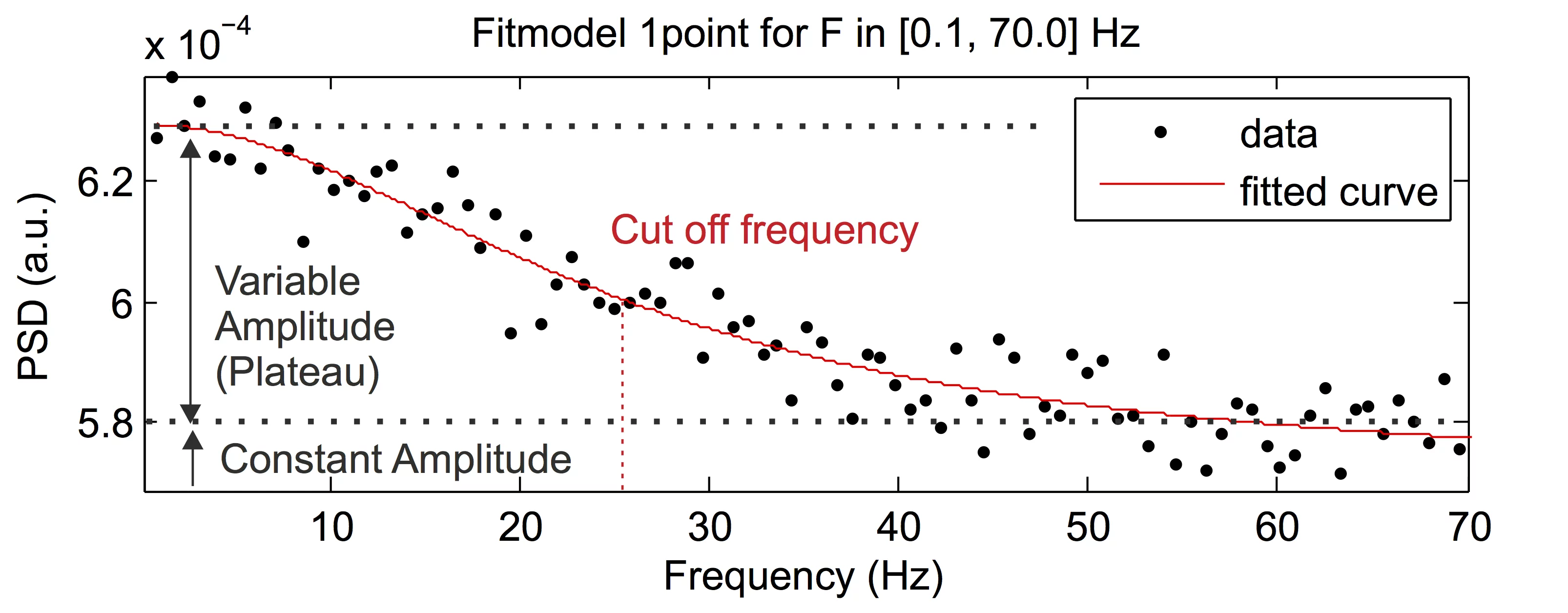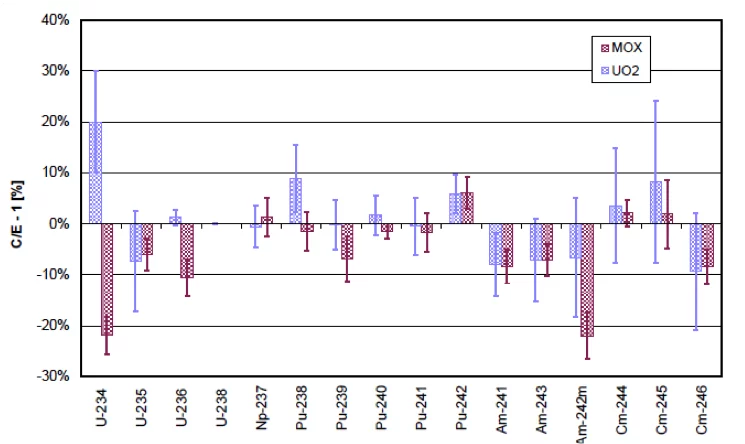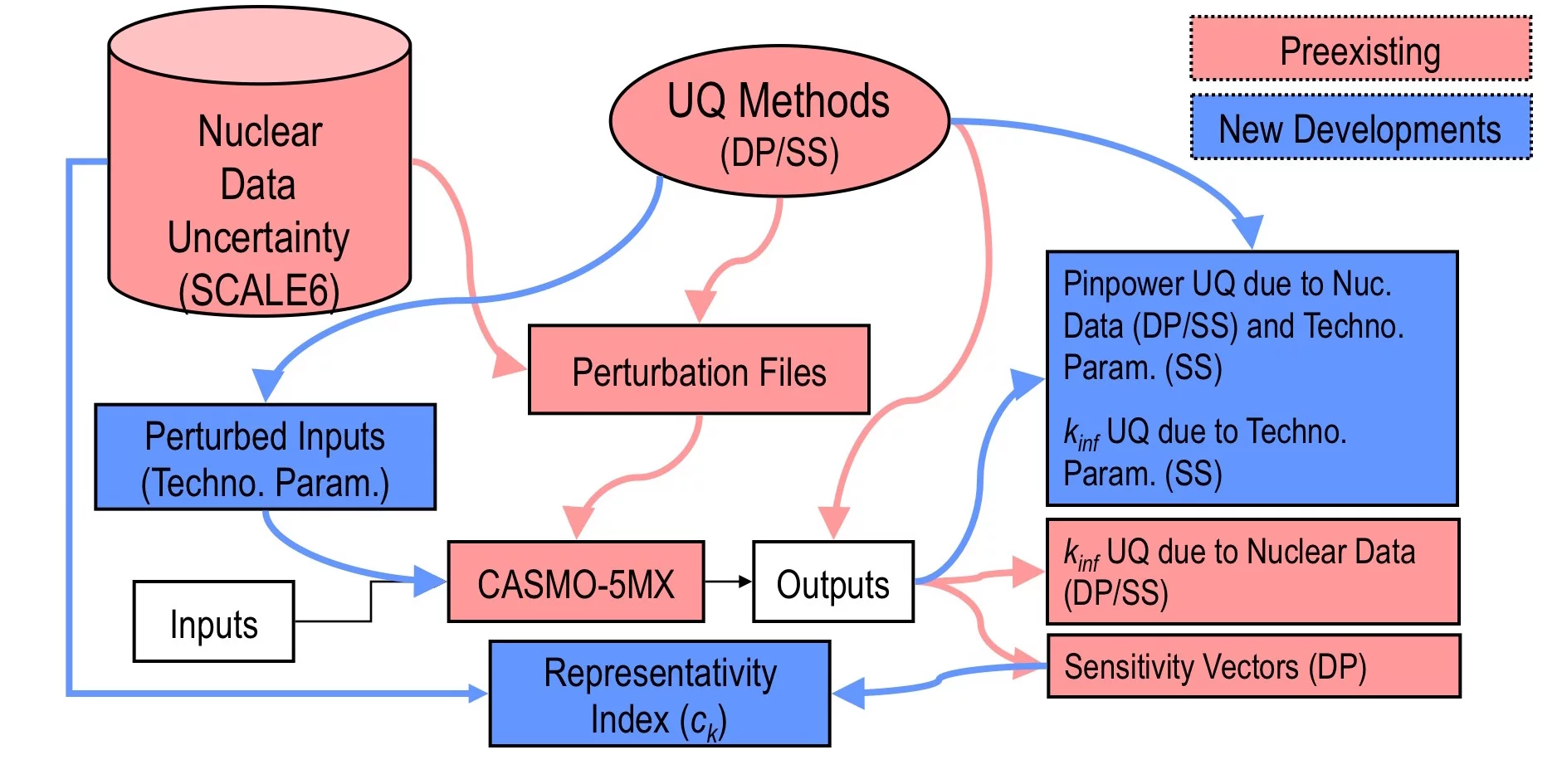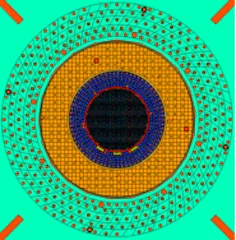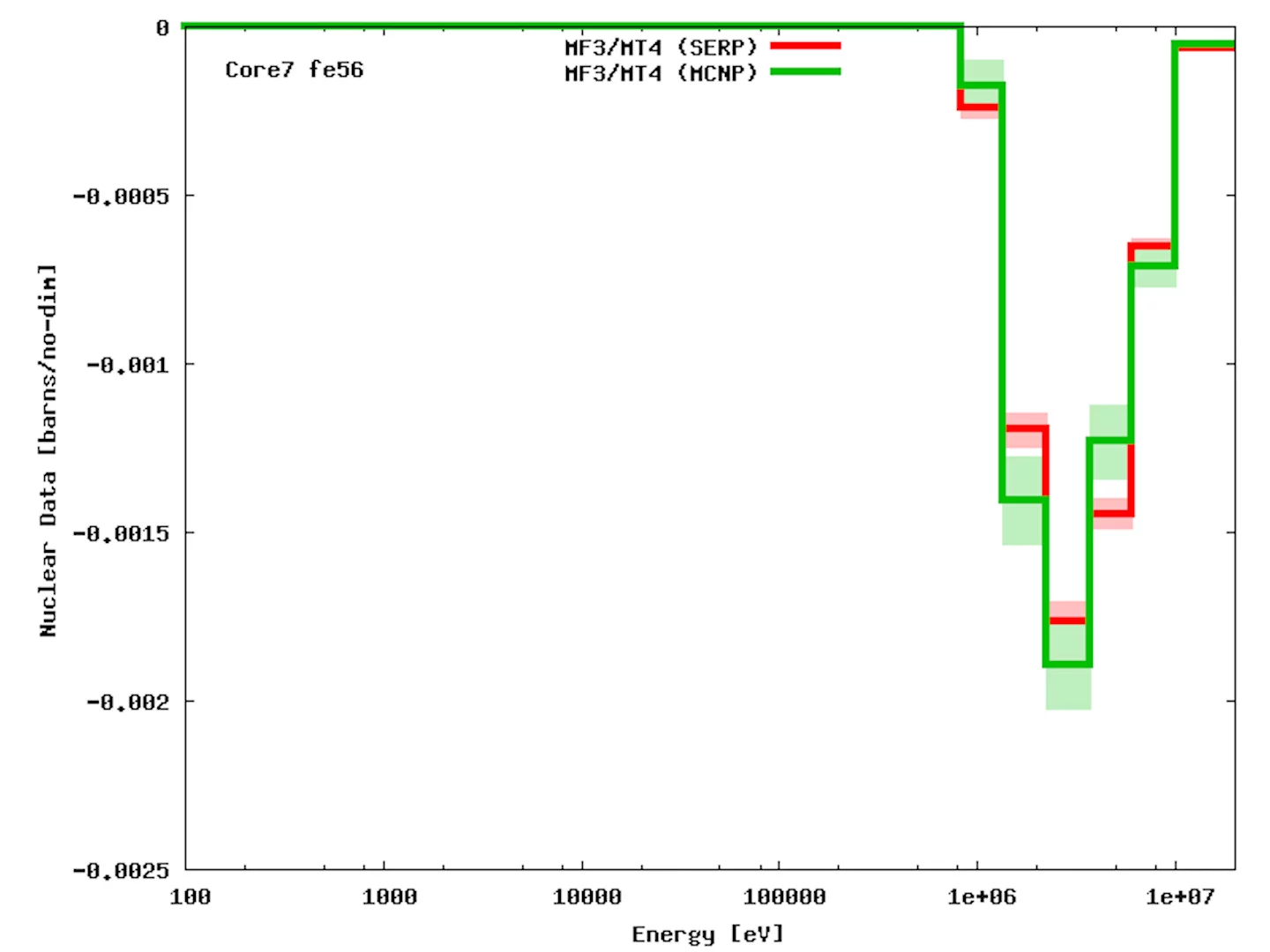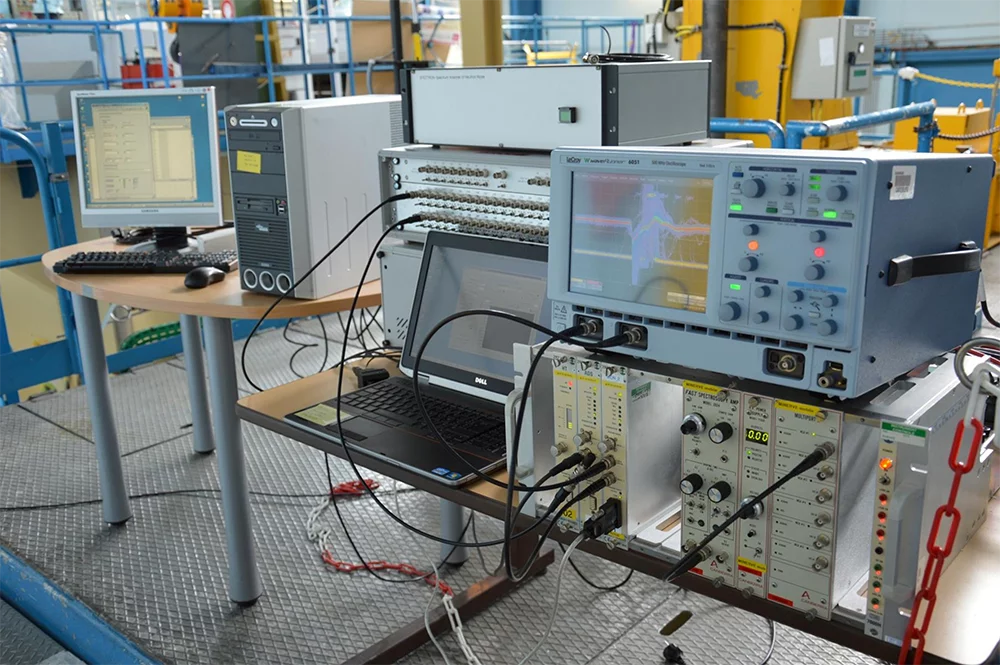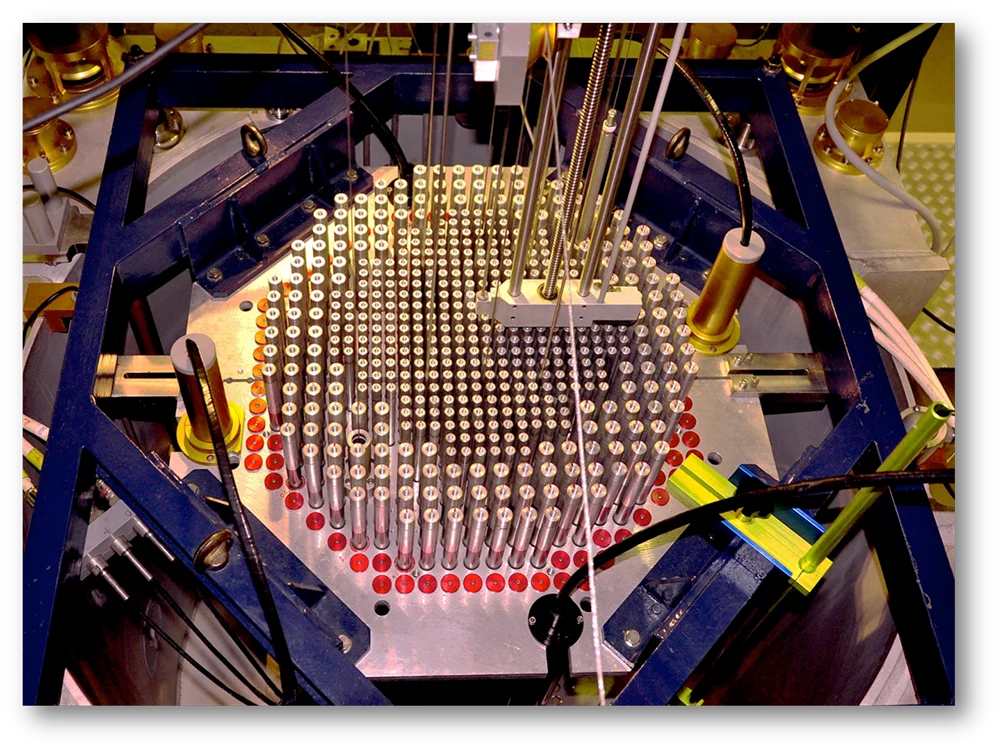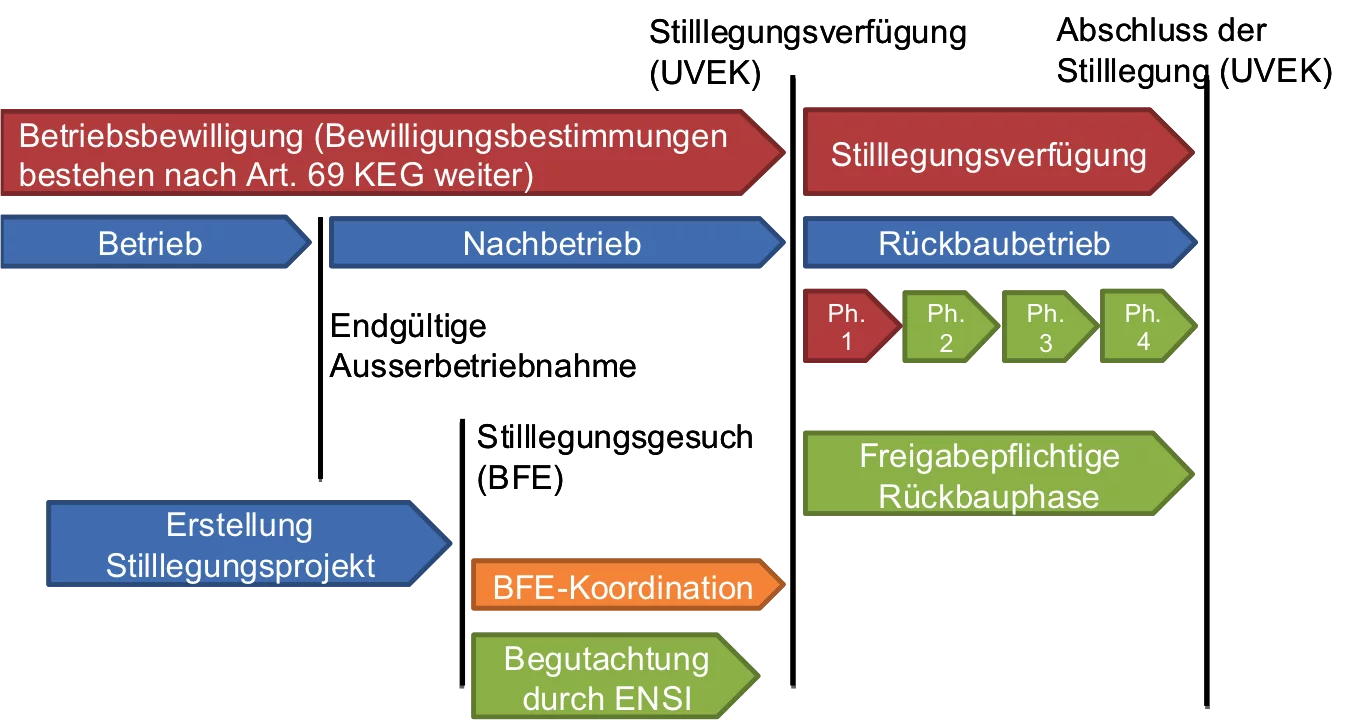Neutron noise measurement of kinetic parameters in CROCUS and MINERVE
(G. Perret)Collaboration with CEA Cadarache and SCK.CEN
A neutron noise measurement system was developed and used to measure the delayed neutron fraction and the generation time of the CROCUS (EPFL) and MINERVE (CEA-Cadarache) zero-power reactors. The station uses up to four detectors and fast multi-channel scaler cards to record the auto- and inter-correlations of the signals with resolutions of up to 100ns. The Feynman and Power Spectral Density techniques (see illustration) are used to determine the kinetic parameter of interest.
Spent fuel neutron source at Hot-Laboratory of PSI
(G. Perret)A neutron measurement system is to be built in the hot-cell of the Hot-Laboratory of PSI to measure the neutron source intensity emitted by spent fuel. The measurements are performed with detectors sensitive to thermal and fast neutrons on well characterised spent fuel samples. The reactivity effects of the samples were measured during the former LWR-PROTEUS programme, and the isotopic concentrations of more than 50 elements relevant for reactivity and neutron emissions were measured by destructive analysis. Such fine characterisation allows accurate comparison of neutron source measurements and deduced burn-up to code predictions. In a later phase, the measurement system could be used to measure the neutron source along a full-length rod and reconstruct the axial neutron source and burn-up profiles (see illustration) in a reasonable time.
CASMO-5 validation for depletion calculations and burnup credit
(P. Grimm)The aim of this project is to validate the CASMO-5 fuel assembly neutronics code for the prediction of isotopic composition and reactivity loss of highly-burnt fuel using the measurements performed on burnt fuel samples from Swiss nuclear power plants in Phase II of the LWR-PROTEUS project. A total of 13 samples, 11 of which originated from KKG (7 UO2, 4 MOX) and 2 from KKL, were investigated in these experiments. The burnups of the samples range up to 120 MWd/kg for UO2 and to 70 MWd/kg for MOX.
As an example, the agreement between the predictions and the experiments is illustrated for the isotopic compositions of the actinides aggregated on all UO2 and all MOX samples.
CASMO-5 developments for sensitivity profiles and similarity indices
(M. Hursin, D. Siefman)Methods for uncertainty quantification (UQ) and representativity analysis (RA) were developed for the CASMO-5M code. The implementation of the methods are shown in the illustration.
The UQ methods are used to assess the sensitivity profiles and the uncertainties of neutronics parameters (e.g. multiplication constant, pin power, reactivity worth) due to nuclear data cross-sections and technological parameter uncertainties. Uncertainties on the nuclear data originated from various modern covariance matrices (e.g. SCALE, ENDF/B-VII.1). Among the considered technological parameters were lattice pitch, fuel and moderator composition, fuel geometry. The methods were applied to the CASMO-5 predictions for the different phases of the LWR-PROTEUS programme. Experimental results could be compared anew with the CASMO-5 predictions now comprising uncertainties due to nuclear data and technological parameters.
The representativity analysis methods produce representativity indices that quantify how similar is a zero-power reactor experiment as compared to the conditions encountered in a nuclear power plant. This method is used for example to demonstrate how similar are pin powers measured in SVEA-96 Optima2 fresh assemblies loaded in PROTEUS during Phase III of the LWR-PROTEUS programme to that found in the same fuel assemblies loaded in a nuclear power plant at zero hot power conditions and for different void concentrations. A high similarity guarantee that the validation of the code on the LWR-PROTEUS experiments is relevant for the conditions encountered in real BWR.
Re-analysis of GCFR-PROTEUS experiments with Thorium
(G. Perret, R. Pattupara)Collaboration with Univ. of Florida (G. Newman, K. Jordan)
In the 1970's the Gas Cooled Fast Reactor experiments were performed in PROTEUS. Large amount of experimental data were collected and analysed with codes in the 1980's. Because of its unique spectral features, this project aimed at re-analysing part of the experiments with modern computer and nuclear data libraries. A 3D model of the core was built for the Monte-Carlo code MCNP. The initial effort focused on the re-interpretation of the spectral index measurements performed in a regular hexagonal lattices of (U,Pu)O2 rods. This work demonstrated for example some trend in the fission cross-sections of Th-232 in ENDF/B-VII.1 and in the capture cross-sections of Np-237 in JEFF-3.1 and JEFF-3.1.1, which are helpful to reevaluate the data in future release.
As a next step, a proposal to reevaluate a larger set of GCFR-PROTEUS configurations was submitted with the University of Florida to the Nuclear Energy University Program sponsored by DOE (NEUP) and accepted. All measurements of the selected configurations will be modelled (e.g. spectral indices, reaction rate distribution, reactivity effects) and results will be documented as a new benchmark in the International Handbook of Evaluated Reactor Physics Benchmark Experiments (IRPhEP Handbook).
Re-analysis of HCLWR-PROTEUS experiments
(M. Hursin, G. Perret, E. Vlassopoulos)Collaboration with SG-39 OECD/NEA
In the 1980's the High Conversion Light Water experiments were performed in PROTEUS. About twenty different core configurations were studied allowing the measurement of, among others, the reactivity effects associated with the voidage of the fuel lattice. Similarly to the GCFR experiments, the HCLWR-PROTEUS experiments started to be re-analysed with modern Monte-Carlo codes and nuclear data libraries. These experiments are of particular interest because of their intermediate spectra. Initial efforts were spent to characterise the cell lattices in terms of multiplication constant, and sensitivity profiles (see illustration) and reproduce the measured spectral index values. The results could help using the experiments in the framework of the WPEC Subgroup 39 of the OECD/NEA to improve of nuclear data files.
Comparison of generation time and delayed neutron fraction predictions with Monte-Carlo codes
(G. Perret)Collaboration with CEA Cadarache and SCK.CEN
Predictions of delayed neutron fractions and generation times are a rather new feature of Monte-Carlo codes. These methods need to be validated against experimental data. This project aims at comparing the results provided by MCNP-5/6, MCNP-LAMBDA (developed by SCK.CEN) and TRIPOLI-4 to the experimental values measured on the pool of facilities and experimental programmes available in the three institutes making up the collaboration. The configurations selected pertain to FREYA (VENUS), MUSE-4 (MASURCA), HTR-PROTEUS, LWR-PROTEUS, CROCUS, R1-UO2 (MINERVE).
Definition of new experiments for the CROCUS reactor and LOTUS cavity
(V. Lamirand, M. Hursin, P. Frajtag, G. Perret)Partnership with EPFL/LRS
LRS is prospecting ways to extend its experimental research activities toward its EPFL facilities, including the CROCUS reactor and the irradiation cavity LOTUS. The aim is to develop experimental programmes on reactor physics, instrumentation and nuclear data measurements. Some projects envisaged are: qualification of reflector materials for GEN-III reactors, mechanical noise and void measurements with neutron noise techniques, diamond detectors uses in zero-power reactors, irradiation damage in scintillators. More information is available here.
Decommissioning of PROTEUS
(F. Leibundgut)The PROTEUS decommissioning process started in 2012 and legally comprises three phases: end of operation(Betrieb), post-operation (Nachbetrieb) and dismantling (Rückbaubetrieb). At the end of the decommissioning process, the reactor building will not be a nuclear facility anymore. As of beginning 2015, the project is in the post-operation phase. The core is completely unloaded and the fuel is stored safely. The complete inventory of all nuclear material was performed and part of the material was already disposed of. Plans for the dismantling phase were submitted to the safety authorities and the dismantlement will start after disposal of the fuel.

